ProSoft Technology MVI69-PDPMV1 User Manual

MVI69-PDPMV1
CompactLogix or MicroLogix
Platform
PROFIBUS DPV1 Master
July 8, 2011
USER MANUAL
Your Feedback Please
We always want you to feel that you made the right decision to use our products. If you have suggestions, comments, compliments or complaints about our products, documentation, or support, please write or call us.
How to Contact Us
ProSoft Technology
5201 Truxtun Ave., 3rd Floor Bakersfield, CA 93309
+1 (661) 716-5100
+1 (661) 716-5101 (Fax) www.prosoft-technology.com support@prosoft-technology.com
Copyright © 2011 ProSoft Technology, Inc., all rights reserved.
MVI69-PDPMV1 User Manual
July 8, 2011
ProSoft Technology ®, ProLinx ®, inRAx ®, ProTalk ®, and RadioLinx ® are Registered Trademarks of ProSoft Technology, Inc. All other brand or product names are or may be trademarks of, and are used to identify products and services of, their respective owners.
ProSoft Technology® Product Documentation
In an effort to conserve paper, ProSoft Technology no longer includes printed manuals with our product shipments. User Manuals, Datasheets, Sample Ladder Files, and Configuration Files are provided on the enclosed CD-ROM in Adobe® Acrobat Reader file format (.PDFs). These product documentation files may also be freely downloaded from our web site: www.prosoft-technology.com

Important Installation Instructions
Power, Input, and Output (I/O) wiring must be in accordance with Class I, Division 2 wiring methods, Article 501-4 (b) of the National Electrical Code, NFPA 70 for installation in the U.S., or as specified in Section 18-1J2 of the Canadian Electrical Code for installations in Canada, and in accordance with the authority having jurisdiction. The following warnings must be heeded:
WARNING - EXPLOSION HAZARD - SUBSTITUTION OF COMPONENTS MAY IMPAIR SUITABILITY FOR CLASS I, DIV. 2;
WARNING - EXPLOSION HAZARD - WHEN IN HAZARDOUS LOCATIONS, TURN OFF POWER BEFORE REPLACING OR WIRING MODULES
WARNING - EXPLOSION HAZARD - DO NOT DISCONNECT EQUIPMENT UNLESS POWER HAS BEEN SWITCHED OFF OR THE AREA IS KNOWN TO BE NON-HAZARDOUS.
THIS DEVICE SHALL BE POWERED BY CLASS 2 OUTPUTS ONLY.
MVI (Multi Vendor Interface) Modules
WARNING - EXPLOSION HAZARD - DO NOT DISCONNECT EQUIPMENT UNLESS POWER HAS BEEN SWITCHED OFF OR THE AREA IS KNOWN TO BE NON-HAZARDOUS.
AVERTISSEMENT - RISQUE D'EXPLOSION - AVANT DE DÉCONNECTER L'ÉQUIPEMENT, COUPER LE COURANT OU S'ASSURER QUE L'EMPLACEMENT EST DÉSIGNÉ NON DANGEREUX.
Warnings
North America Warnings
AWarning - Explosion Hazard - Substitution of components may impair suitability for Class I, Division 2.
BWarning - Explosion Hazard - When in hazardous locations, turn off power before replacing or rewiring modules. Warning - Explosion Hazard - Do not disconnect equipment unless power has been switched off or the area is known to be non-hazardous.
CSuitable for use in Class I, Division 2 Groups A, B, C and D Hazardous Locations or Non-Hazardous Locations.
ATEX Warnings and Conditions of Safe Usage
Power, Input, and Output (I/O) wiring must be in accordance with the authority having jurisdiction.
AWarning - Explosion Hazard - When in hazardous locations, turn off power before replacing or wiring modules.
BWarning - Explosion Hazard - Do not disconnect equipment unless power has been switched off or the area is known to be non-hazardous.
CThese products are intended to be mounted in an IP54 enclosure. The devices shall provide external means to prevent the rated voltage being exceeded by transient disturbances of more than 40%. This device must be used only with ATEX certified backplanes.
DDO NOT OPEN WHEN ENERGIZED.
Warning: This module is not hot-swappable! Always remove power from the rack before inserting or removing this module, or damage may result to the module, the processor, or other connected devices.

Battery Life Advisory
The MVI46, MVI56, MVI56E, MVI69, and MVI71 modules use a rechargeable Lithium Vanadium Pentoxide battery to backup the real-time clock and CMOS. The battery should last for the life of the module. The module must be powered for approximately twenty hours before the battery becomes fully charged. After it is fully charged, the battery provides backup power for the CMOS setup and the real-time clock for approximately 21 days. When the battery is fully discharged, the module will revert to the default BIOS and clock settings.
Note: The battery is not user replaceable.
Markings
Electrical Ratings
Backplane Current Load: 800 mA @ 5.1 Vdc
Power Supply Distance Rating: 2
Operating Temperature: 0°C to 60°C (32°F to 140°F)
Storage Temperature: -40°C to 85°C (-40°F to 185°F)
Relative Humidity: 5% to 95% (with no condensation)
All phase conductor sizes must be at least 1.3 mm(squared) and all earth ground conductors must be at least 4mm(squared).
Label Markings
<cULus>
E193122 Class I Div 2
Groups A,B,C,D T6 -30°C <= Ta <= 60°C <Ex>
II 3 G
Ex nA IIc T6 X
0°C <= Tamb <= 60°C
II - Equipment intended for above ground use (not for use in mines). 3 - Category 3 equipment, investigated for normal operation only. G - Equipment protected against explosive gasses.
Agency Approvals and Certifications
Agency |
Applicable Standard(s) |
ATEX |
EN 60079-0:2006, EN 60079-15:2005 |
|
|
DNV |
DET NORSKE VERITAS Test 2.4 |
|
|
CE |
EN61000-6-4:2007 |
CB Safety |
CA/10533/CSA, IEC 61010-1 Ed. 2, CB 243333-2056722 |
|
(2090408) |
GOST-R |
EN 61010 |
CSA |
61010 |
cULus |
UL508, UL1604, CSA 22.2 No 142 & 213 |
Lloyds |
Lloyds Register Test Specification Number 1,2002 |
ME06 |
E193122 |
MVI69-PDPMV1 ♦ CompactLogix or MicroLogix Platform |
Contents |
PROFIBUS DPV1 Master |
User Manual |
|
|
Contents
|
|
Your Feedback Please........................................................................................................................ |
2 |
||
|
|
How to Contact Us .............................................................................................................................. |
2 |
||
|
|
ProSoft Technology® Product Documentation.................................................................................... |
2 |
||
|
|
Important Installation Instructions ....................................................................................................... |
3 |
||
|
|
MVI (Multi Vendor Interface) Modules ................................................................................................ |
3 |
||
|
|
Warnings ............................................................................................................................................. |
|
3 |
|
|
|
Battery Life Advisory ........................................................................................................................... |
4 |
||
|
|
Markings.............................................................................................................................................. |
|
4 |
|
|
Guide to the MVI69-PDPMV1 User Manual |
9 |
|||
|
|
|
|
|
|
|
1 |
Start Here |
|
11 |
|
|
|
|
|
|
|
|
|
1.1 |
System Requirements ............................................................................................. |
12 |
|
|
|
1.2 |
Package Contents ................................................................................................... |
13 |
|
|
|
1.3 |
Installing ProSoft Configuration Builder Software ................................................... |
14 |
|
|
|
1.4 |
Setting Jumpers ...................................................................................................... |
15 |
|
|
|
1.5 |
Installing the Module ............................................................................................... |
16 |
|
|
2 |
Ladder Logic |
19 |
||
|
|
|
|
|
|
|
|
2.1 |
MVI69-PDPMV1 Sample Add-On Instruction Import Procedure............................. |
20 |
|
|
|
2.1.1 |
Creating a New RSLogix5000 Project..................................................................... |
21 |
|
|
|
2.1.2 |
Creating the Module ................................................................................................ |
21 |
|
|
|
2.1.3 |
Importing the Ladder Rung ..................................................................................... |
24 |
|
|
|
2.1.4 |
Adding Multiple Modules (Optional) ........................................................................ |
28 |
|
|
|
2.1.5 |
Connecting Your PC to the Processor .................................................................... |
35 |
|
|
|
2.1.6 |
Downloading the Sample Program to the Processor .............................................. |
36 |
|
|
|
2.2 |
Adding the Module to an Existing CompactLogix Project ....................................... |
39 |
|
|
|
2.3 |
Adding the Module to an Existing MicroLogix Project............................................. |
43 |
|
|
3 |
Module Setup |
45 |
||
|
|
|
|
|
|
|
|
3.1 |
Connecting Your PC to the Module......................................................................... |
46 |
|
|
|
3.2 |
Configuring the Module ........................................................................................... |
47 |
|
|
|
3.2.1 |
Setting Up the Project ............................................................................................. |
47 |
|
|
|
3.2.2 |
Setting Module Parameters..................................................................................... |
49 |
|
|
|
3.2.3 |
Configuring the PROFIBUS Master ........................................................................ |
51 |
|
|
|
3.2.4 |
Installing the GSD Files........................................................................................... |
53 |
|
|
|
3.2.5 |
Configuring the PROFIBUS Slaves......................................................................... |
53 |
|
|
|
3.2.6 |
Calculating the Checksums..................................................................................... |
66 |
|
|
|
3.2.7 |
Printing the Processor Network Memory Map ........................................................ |
66 |
|
|
|
3.3 |
Backing Up the Project............................................................................................ |
68 |
|
|
|
3.4 |
Downloading the Project to the Module Using a Serial COM Port.......................... |
70 |
|
|
|
3.4.1 |
Disabling the RSLinx Driver for the Com Port on the PC........................................ |
71 |
|
|
|
3.5 |
Downloading the Project to the Module Using CIPconnect .................................... |
73 |
|
|
|
3.5.1 |
Example................................................................................................................... |
75 |
|
|
|
|
|
|
|
ProSoft Technology, Inc. |
|
Page 5 of 225 |
|||
July 8, 2011 |
|
|
|
||

Contents |
|
MVI69-PDPMV1 ♦ CompactLogix or MicroLogix Platform |
|||
User Manual |
|
|
PROFIBUS DPV1 Master |
||
|
|
|
|
|
|
|
4 |
Mailbox Messaging |
81 |
||
|
|
|
|
|
|
|
4.1 |
|
Mailbox Message Queuing ..................................................................................... |
82 |
|
|
|
4.1.1 |
Queue Timeouts ..................................................................................................... |
82 |
|
4.2 |
|
Sending a Mailbox Message in RSLogix 5000 ....................................................... |
83 |
||
4.3 |
|
Receiving Mailbox Message Responses from the Module..................................... |
84 |
||
4.4 |
|
Special Function Mailbox Messaging Commands.................................................. |
85 |
||
|
|
4.4.1 |
Mailbox Message: Set Operating Mode ................................................................. |
88 |
|
|
|
4.4.2 |
Mailbox Message: Set Slave Mode ........................................................................ |
90 |
|
|
|
4.4.3 |
Mailbox Message: Get Slave Diagnostics .............................................................. |
94 |
|
|
|
4.4.4 |
Mailbox Message: Get Slave Configuration ........................................................... |
96 |
|
|
|
4.4.5 |
Mailbox Message: Set Slave Address .................................................................... |
98 |
|
|
|
4.4.6 |
Mailbox Message: Get Live List............................................................................ |
100 |
|
|
|
4.4.7 |
Mailbox Message: Start Slave .............................................................................. |
102 |
|
|
|
4.4.8 |
Mailbox Message: Stop Slave .............................................................................. |
104 |
|
|
|
4.4.9 |
Mailbox Message: Class 1 Acyclic Data Read ..................................................... |
106 |
|
|
|
4.4.10 |
Mailbox Message: Class 1 Acyclic Data Write ..................................................... |
108 |
|
|
|
4.4.11 |
Mailbox Message: Initiate Class 2 Connection..................................................... |
110 |
|
|
|
4.4.12 |
Mailbox Message: Class 2 Acyclic Data Read ..................................................... |
116 |
|
|
|
4.4.13 |
Mailbox Message: Class 2 Acyclic Data Write ..................................................... |
118 |
|
|
|
4.4.14 |
Mailbox Message: Abort Class 2 Connection....................................................... |
120 |
|
|
|
4.4.15 |
Mailbox Message: Class 2 Connection Abort Indication ...................................... |
122 |
|
|
|
4.4.16 |
Mailbox Message: Alarm Indication...................................................................... |
126 |
|
4.5 |
|
Mailbox Messaging Error Codes........................................................................... |
128 |
||
|
|
4.5.1 |
Acyclic Message Status Word .............................................................................. |
128 |
|
|
|
4.5.2 |
Return Codes........................................................................................................ |
129 |
|
|
|
4.5.3 |
Error Codes........................................................................................................... |
130 |
|
|
|
4.5.4 |
DPV1 Class 1-Related Error Codes ..................................................................... |
131 |
|
|
|
4.5.5 |
DPV1 Class 2-Related Error Codes ..................................................................... |
132 |
|
|
5 |
Diagnostics and Troubleshooting |
133 |
||
|
|
|
|
|
|
|
5.1 |
|
Verifying Correct Operation .................................................................................. |
134 |
|
|
|
5.1.1 |
Checking the PROFIBUS LEDs on the MVI69-PDPMV1..................................... |
134 |
|
|
|
5.1.2 |
Viewing the Online Status of the PROFIBUS Network......................................... |
135 |
|
5.1.3Viewing the Fieldbus Data from the MVI69-PDPMV1’s Configuration/Debug Menu137
5.1.4 |
Viewing the Controller Tags in RSLogix 5000 ...................................................... |
141 |
|
5.2 |
Basic Troubleshooting Steps ................................................................................ |
143 |
|
5.3 |
LED Indicators: Front of MVI69 Module ............................................................... |
144 |
|
5.3.1 |
Module Status Indicators ...................................................................................... |
144 |
|
5.3.2 |
PROFIBUS Master Indicators............................................................................... |
145 |
|
5.4 |
Using ProSoft Configuration Builder (PCB) for Diagnostics ................................. |
147 |
|
5.4.1 |
Using the Diagnostic Window in ProSoft Configuration Builder ........................... |
147 |
|
5.4.2 |
Navigation ............................................................................................................. |
150 |
|
5.4.3 |
Main Menu ............................................................................................................ |
151 |
|
5.5 |
Reading Status Data from the Module ................................................................. |
154 |
|
5.6 |
Standard PROFIBUS Slave Diagnostic Bytes...................................................... |
155 |
|
5.6.1 |
Byte 0 - Station Status 1 Bits ................................................................................ |
155 |
|
5.6.2 |
Byte 1 - Station Status 2 Bits ................................................................................ |
155 |
|
5.6.3 |
Byte 2 |
- Station Status 3 Bits ................................................................................ |
156 |
5.6.4 |
Byte 3 |
- Master Address ....................................................................................... |
156 |
5.6.5 |
Byte 4 |
- Ident Number High .................................................................................. |
156 |
5.6.6 |
Byte 5 |
- Ident Number Low ................................................................................... |
156 |
Page 6 of 225 |
|
ProSoft Technology, Inc. |
|
|
|
|
July 8, 2011 |
MVI69-PDPMV1 ♦ CompactLogix or MicroLogix Platform |
Contents |
||||
PROFIBUS DPV1 Master |
|
User Manual |
|||
|
|
|
|
|
|
|
6 |
Reference |
|
157 |
|
|
|
|
|
|
|
|
|
6.1 |
Product Specifications........................................................................................... |
157 |
|
|
|
6.1.1 |
General Specifications .......................................................................................... |
158 |
|
|
|
6.1.2 |
Hardware Specifications........................................................................................ |
158 |
|
|
|
6.1.3 |
Functional Specifications....................................................................................... |
159 |
|
|
|
6.2 |
PROFIBUS DP Architecture.................................................................................. |
160 |
|
|
|
6.2.1 |
Bus Access............................................................................................................ |
161 |
|
|
|
6.2.2 |
Token Passing....................................................................................................... |
161 |
|
|
|
6.2.3 |
Master/Slave Communication Phases .................................................................. |
161 |
|
|
|
6.2.4 |
Communication Types........................................................................................... |
161 |
|
|
|
6.2.5 |
Master/Slave Polling.............................................................................................. |
162 |
|
|
|
6.3 |
Functional Overview.............................................................................................. |
163 |
|
|
|
6.3.1 |
About the PROFIBUS Protocol ............................................................................. |
163 |
|
|
|
6.3.2 |
General Overview.................................................................................................. |
163 |
|
|
|
6.3.3 |
Block Numbers for Transfer .................................................................................. |
165 |
|
|
|
6.3.4 |
MVI69 Input and Output Data Blocks.................................................................... |
167 |
|
|
|
6.4 |
PROFIBUS comDTM ............................................................................................ |
184 |
|
|
|
6.4.1 |
ProSoft Technology Product Availability ............................................................... |
185 |
|
|
|
6.4.2 |
Introduction to PROFIBUS comDTM .................................................................... |
185 |
|
|
|
6.4.3 |
Installation ............................................................................................................. |
189 |
|
|
|
6.4.4 |
Quick Start............................................................................................................. |
190 |
|
|
|
6.4.5 |
Verifying the comDTM Version and comDTM Install Version ............................... |
199 |
|
|
|
6.5 |
RS-232 Configuration/Debug Port ........................................................................ |
205 |
|
|
|
6.6 |
DB9 to RJ45 Adaptor (Cable 14) .......................................................................... |
205 |
|
|
|
6.7 |
PROFIBUS Master Port ........................................................................................ |
206 |
|
|
|
6.8 |
Supported PROFIBUS Services ........................................................................... |
207 |
|
|
|
6.9 |
Constructing a Bus Cable for PROFIBUS DP....................................................... |
208 |
|
|
7 |
Support, Service & Warranty |
213 |
||
|
|
|
|
|
|
|
|
Contacting Technical Support......................................................................................................... |
213 |
||
|
|
7.1 |
Return Material Authorization (RMA) Policies and Conditions.............................. |
215 |
|
|
|
7.1.1 |
Returning Any Product .......................................................................................... |
215 |
|
|
|
7.1.2 |
Returning Units Under Warranty ........................................................................... |
216 |
|
|
|
7.1.3 |
Returning Units Out of Warranty ........................................................................... |
216 |
|
|
|
7.2 |
LIMITED WARRANTY........................................................................................... |
217 |
|
|
|
7.2.1 |
What Is Covered By This Warranty....................................................................... |
217 |
|
|
|
7.2.2 |
What Is Not Covered By This Warranty ................................................................ |
218 |
|
|
|
7.2.3 |
Disclaimer Regarding High Risk Activities ............................................................ |
218 |
|
|
|
7.2.4 |
Intellectual Property Indemnity.............................................................................. |
219 |
|
|
|
7.2.5 |
Disclaimer of all Other Warranties ........................................................................ |
219 |
|
|
|
7.2.6 |
Limitation of Remedies **...................................................................................... |
220 |
|
|
|
7.2.7 |
Time Limit for Bringing Suit ................................................................................... |
220 |
|
|
|
7.2.8 |
No Other Warranties ............................................................................................. |
220 |
|
|
|
7.2.9 |
Allocation of Risks ................................................................................................. |
220 |
|
|
|
7.2.10 |
Controlling Law and Severability........................................................................... |
221 |
|
|
Index |
|
223 |
||
|
|
|
|
|
|
ProSoft Technology, Inc. |
Page 7 of 225 |
July 8, 2011 |
|
Contents |
MVI69-PDPMV1 ♦ CompactLogix or MicroLogix Platform |
User Manual |
PROFIBUS DPV1 Master |
|
|
Page 8 of 225 |
ProSoft Technology, Inc. |
|
July 8, 2011 |
MVI69-PDPMV1 ♦ CompactLogix or MicroLogix Platform |
Guide to the MVI69-PDPMV1 User Manual |
PROFIBUS DPV1 Master |
User Manual |
|
|
Guide to the MVI69-PDPMV1 User Manual
Function |
|
Section to Read |
Details |
|
|
|
|
Introduction |
|
Start Here (page 11) |
This section introduces the customer to the |
(Must Do) |
|
|
module. Included are: package contents, |
|
|
|
system requirements, hardware installation, and |
|
|
|
basic configuration. |
|
|
|
|
|
|
|
|
Diagnostic and |
|
Diagnostics and |
This section describes Diagnostic and |
Troubleshooting |
|
Troubleshooting |
Troubleshooting procedures. |
|
|
(page 133) |
|
|
|
|
|
|
|
|
|
Reference |
|
Reference (page |
These sections contain general references |
|
|
157) |
associated with this product and its |
Product Specifications |
|
Product |
Specifications.. |
|
|
|
|
|
|
Specifications (page |
|
|
|
157) |
|
|
|
|
|
|
|
|
|
Support, Service, and |
|
Support, Service |
This section contains Support, Service and |
Warranty |
|
and Warranty (page |
Warranty information. |
|
|
213) |
|
Index |
|
Index |
Index of chapters. |
|
|
|
ProSoft Technology, Inc. |
Page 9 of 225 |
July 8, 2011 |
|
Guide to the MVI69-PDPMV1 User Manual |
MVI69-PDPMV1 ♦ CompactLogix or MicroLogix Platform |
User Manual |
PROFIBUS DPV1 Master |
|
|
Page 10 of 225 |
ProSoft Technology, Inc. |
|
July 8, 2011 |
MVI69-PDPMV1 ♦ CompactLogix or MicroLogix Platform |
Start Here |
PROFIBUS DPV1 Master |
User Manual |
|
|
1 |
Start Here |
|
|
|
In This Chapter |
|
|
|
|
System Requirements ........................................................................... |
12 |
|
|
Package Contents ................................................................................. |
13 |
|
Installing ProSoft Configuration Builder Software.................................. |
14 |
|
|
|
Setting Jumpers .................................................................................... |
15 |
|
|
Installing the Module ............................................................................. |
16 |
To get the most benefit from this User Manual, you should have the following skills:
Rockwell Automation® RSLogix™ software: launch the program, configure ladder logic, and transfer the ladder logic to the processor
Microsoft Windows: install and launch programs, execute menu commands, navigate dialog boxes, and enter data
Hardware installation and wiring: install the module, and safely connect PROFIBUS DPV1 and CompactLogix or MicroLogix devices to a power source and to the MVI69-PDPMV1 module’s application port(s)
ProSoft Technology, Inc. |
Page 11 of 225 |
July 8, 2011 |
|

Start Here |
MVI69-PDPMV1 ♦ CompactLogix or MicroLogix Platform |
User Manual |
PROFIBUS DPV1 Master |
|
|
1.1System Requirements
The MVI69-PDPMV1 module requires the following minimum hardware and software components:
Rockwell Automation CompactLogix processors or MicroLogix 1500 LRP processor, with compatible power supply and one free slot in the rack, for the MVI69-PDPMV1 module. The module requires 800 mA of available power.
Important: The MVI69-PDPMV1 module has a power supply distance rating of 2 (L43 and L45 installations on first 2 slots of 1769 bus).
Important: For 1769-L23x processors, please make note of the following limitations.
1769-L23-QBFC1B = 800 mA at 5 Vdc (One MVI69-PDPMV1 will use all 800 mA of available power. No other modules can be used with an MVI69 module connected to this processor.)
1769-L23E-QB1B = 1000 mA at 5 Vdc (One MVI69-PDPMV1 will use 800 mA of available power. One other module can be used on this rack provided it consumes less than 200 mA at 5 Vdc.)
1769-L23E-QBFC1B = 450 mA at 5 Vdc (No MVI69 module can be used with this processor.)
Rockwell Automation RSLogix 5000 (CompactLogix) or RSLogix 500
(MicroLogix) programming software
Rockwell Automation RSLinx communication software
Pentium® II 450 MHz minimum. Pentium III 733 MHz (or better) recommended
Supported operating systems:
o Microsoft Windows XP Professional with Service Pack 1 or 2
o Microsoft Windows 2000 Professional with Service Pack 1, 2, or 3
oMicrosoft Windows Server 2003
128 Mbytes of RAM minimum, 256 Mbytes of RAM recommended
100 Mbytes of free hard disk space (or more based on application requirements)
256-color VGA graphics adapter, 800 x 600 minimum resolution (True Color 1024 768 recommended)
CD-ROM drive
HyperTerminal or other terminal emulator program capable of file transfers using Ymodem protocol.
NOTE: MVI69/PS69 modules will not work with CompactLogix L4x processors using RSLogix 5000 v17. All other processor combinations and RSLogix versions will work correctly.
|
|
|
|
|
|
|
|
Page 12 of 225 |
ProSoft Technology, Inc. |
||
|
|
July 8, 2011 |
|

MVI69-PDPMV1 ♦ CompactLogix or MicroLogix Platform |
Start Here |
PROFIBUS DPV1 Master |
User Manual |
|
|
1.2Package Contents
The following components are included with your MVI69-PDPMV1 module, and are all required for installation and configuration.
Important: Before beginning the installation, please verify that all of the following items are present.
|
|
|
|
|
|
|
|
|
|
|
|
|
Qty. |
Part Name |
Part Number |
Part Description |
|
1 |
MVI69-PDPMV1 |
MVI69-PDPMV1 |
PROFIBUS DPV1 Master |
||
|
|
Module |
|
|
|
1 |
Cable |
Cable #15, RS232 |
For RS232 Connection to the CFG Port |
||
|
|
|
Null Modem |
|
|
1 |
Cable |
Cable #14, RJ45 to |
For DB9 Connection to Module’s Port |
||
|
|
|
DB9 Male Adapter |
|
|
|
|
|
cable |
|
|
If any of these components are missing, please contact ProSoft Technology Support for replacement parts.
ProSoft Technology, Inc. |
Page 13 of 225 |
July 8, 2011 |
|

Start Here |
MVI69-PDPMV1 ♦ CompactLogix or MicroLogix Platform |
User Manual |
PROFIBUS DPV1 Master |
|
|
1.3Installing ProSoft Configuration Builder Software
You must install the ProSoft Configuration Builder (PCB) software to configure the module. You can always get the newest version of ProSoft Configuration Builder from the ProSoft Technology website.
To install ProSoft Configuration Builder from the ProSoft Technology website
1Open your web browser and navigate to http://www.prosofttechnology.com/pcb
2Click the DOWNLOAD HERE link to download the latest version of ProSoft Configuration Builder.
3Choose SAVE or SAVE FILE when prompted.
4Save the file to your Windows Desktop, so that you can find it easily when you have finished downloading.
5When the download is complete, locate and open the file, and then follow the instructions on your screen to install the program.
If you do not have access to the Internet, you can install ProSoft Configuration Builder from the ProSoft Solutions Product CD-ROM, included in the package with your module.
To install ProSoft Configuration Builder from the Product CD-ROM
1Insert the ProSoft Solutions Product CD-ROM into the CD-ROM drive of your PC. Wait for the startup screen to appear.
2On the startup screen, click PRODUCT DOCUMENTATION. This action opens a
Windows Explorer file tree window.
3Click to open the UTILITIES folder. This folder contains all of the applications and files you will need to set up and configure your module.
4Double-click the SETUP CONFIGURATION TOOL folder, double-click the PCB_*.EXE file and follow the instructions on your screen to install the software on your PC. The information represented by the "*" character in the file name is the PCB version number and, therefore, subject to change as new versions of PCB are released.
Note: Many of the configuration and maintenance procedures use files and other utilities on the CD-ROM. You may wish to copy the files from the Utilities folder on the CD-ROM to a convenient location on your hard drive.
|
|
|
|
|
|
|
|
Page 14 of 225 |
ProSoft Technology, Inc. |
||
|
|
July 8, 2011 |
|
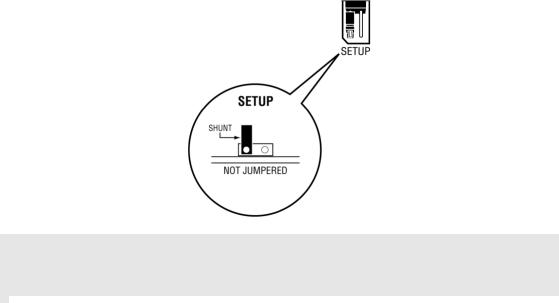
MVI69-PDPMV1 ♦ CompactLogix or MicroLogix Platform |
Start Here |
PROFIBUS DPV1 Master |
User Manual |
|
|
1.4Setting Jumpers
The Setup Jumper acts as "write protection" for the module’s flash memory. In "write protected" mode, the Setup pins are not connected, and the module’s firmware cannot be overwritten. Do not jumper the Setup pins together unless you are directed to do so by ProSoft Technical Support.
The following illustration shows the MVI69-PDPMV1 jumper configuration.
Note: If you are installing the module in a remote rack, you may prefer to leave the Setup pins jumpered. That way, you can update the module’s firmware without requiring physical access to the module.
|
|
|
|
|
|
|
|
ProSoft Technology, Inc. |
Page 15 of 225 |
||
July 8, 2011 |
|
|
|

Start Here |
MVI69-PDPMV1 ♦ CompactLogix or MicroLogix Platform |
User Manual |
PROFIBUS DPV1 Master |
|
|
1.5Installing the Module
Before you attempt to install the module, make sure that the bus lever of the adjacent module is in the unlocked (fully right) position.
Warning: This module is not hot-swappable! Always remove power from the rack before inserting or removing this module, or damage may result to the module, the processor, or other connected devices.
1Align the module using the upper and lower tongue-and-groove slots with the adjacent module and slide forward in the direction of the arrow.
2Move the module back along the tongue-and-groove slots until the bus connectors on the MVI69 module and the adjacent module line up with each other.
Page 16 of 225 |
ProSoft Technology, Inc. |
|
July 8, 2011 |

MVI69-PDPMV1 ♦ CompactLogix or MicroLogix Platform |
Start Here |
PROFIBUS DPV1 Master |
User Manual |
|
|
3Push the module’s bus lever back slightly to clear the positioning tab and move it firmly to the left until it clicks. Ensure that it is locked firmly in place.
4 Close all DIN-rail latches.
ProSoft Technology, Inc. |
Page 17 of 225 |
July 8, 2011 |
|
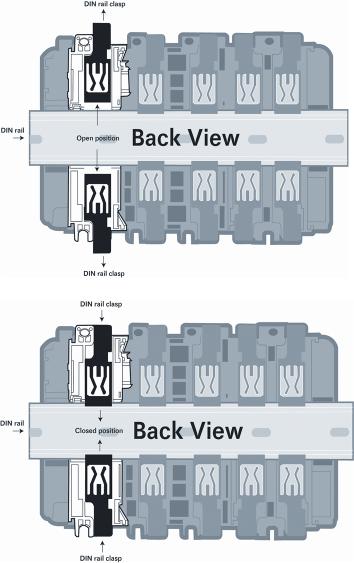
Start Here |
MVI69-PDPMV1 ♦ CompactLogix or MicroLogix Platform |
User Manual |
PROFIBUS DPV1 Master |
|
|
5Press the DIN-rail mounting area of the controller against the DIN-rail. The latches will momentarily open and lock into place.
Page 18 of 225 |
ProSoft Technology, Inc. |
|
July 8, 2011 |
MVI69-PDPMV1 ♦ CompactLogix or MicroLogix Platform |
Ladder Logic |
PROFIBUS DPV1 Master |
User Manual |
|
|
2 |
Ladder Logic |
|
|
|
In This Chapter |
|
|
|
MVI69-PDPMV1 Sample Add-On Instruction Import Procedure............ |
20 |
|
|
|
Adding the Module to an Existing CompactLogix Project ...................... |
39 |
|
|
Adding the Module to an Existing MicroLogix Project............................ |
43 |
Ladder logic is required for the MVI69-PDPMV1 module to work. Tasks that must be handled by the ladder logic are module data transfer, special block handling, and status data receipt. Additionally, a power-up handler may be needed to handle the initialization of the module’s data and to clear any processor fault conditions.
The sample ladder logic, on the inRAx CD-ROM, is extensively commented, to provide information on the purpose and function of each rung. For most applications, the sample ladder will work without modification.
ProSoft Technology, Inc. |
Page 19 of 225 |
July 8, 2011 |
|

Ladder Logic |
MVI69-PDPMV1 ♦ CompactLogix or MicroLogix Platform |
User Manual |
PROFIBUS DPV1 Master |
|
|
2.1MVI69-PDPMV1 Sample Add-On Instruction Import Procedure
Note: This section only applies if you are using a CompactLogix processor running RSLogix 5000 version 16 or higher. If you are configuring the MVI69-PDPMV1 module with an earlier version of RSLogix 5000, please refer to Adding the Module to an Existing CompactLogix Project (page 39). If you are using a MicroLogix processor, please see Adding the Module to an Existing MicroLogix Project (page 43).
The following file is required before you start this procedure. Copy the file from the ProSoft Solutions CD-ROM, or download it from www.prosoft-technology.com.
File Name |
Description |
MVI69PDPMV1(60)_AddOn_Rung_v1_3.L5X |
L5X file contains the Add-On instruction, the |
MVI69PDPMV1(120)_AddOn_Rung_v1_3.L5X |
User-defined Data Types, data objects and ladder |
MVI69PDPMV1(240)_AddOn_Rung_v1_3.L5X |
logic required to set up the MVI69-PDPMV1 |
|
module. |
|
Choose the file with the block size (60, 120 or |
|
240) to match your application. |
MVI69PDPMV1(240)_AddOn_Rung_v1_4.L5X |
L5X file contains all of the standard items |
|
(above), plus additional items for the Add-On |
|
instruction, the User-defined Data Types, data |
|
objects and ladder logic required to set up the |
|
MVI69-PDPMV1 module to act as a PROFIBUS |
|
Acyclic Class 2 Master. |
|
Class 2 sample ladder currently available only for |
|
Backplane Transfer Size of 240. |
Page 20 of 225 |
ProSoft Technology, Inc. |
|
July 8, 2011 |

MVI69-PDPMV1 ♦ CompactLogix or MicroLogix Platform |
Ladder Logic |
PROFIBUS DPV1 Master |
User Manual |
|
|
2.1.1 Creating a New RSLogix5000 Project
1Open the FILE menu, and then choose NEW.
2Select Revision 16.
2.1.2 Creating the Module
1 Right-click I/O CONFIGURATION and choose NEW MODULE.
ProSoft Technology, Inc. |
Page 21 of 225 |
July 8, 2011 |
|

Ladder Logic |
MVI69-PDPMV1 ♦ CompactLogix or MicroLogix Platform |
User Manual |
PROFIBUS DPV1 Master |
|
|
2 |
Select 1769-MODULE. |
3 Set the Module Properties values as follows:
Parameter |
Value |
Name |
Enter a module identification string. Example: |
|
MVI69PDPMV1 |
Description |
Enter a description for the module. Example: PROFIBUS |
|
DPV1 MASTER |
Comm Format |
Select DATA-INT |
Slot |
Enter the slot number in the rack where the MVI69- |
|
PDPMV1 module will be installed. |
Input Assembly Instance |
101 |
Input Size |
62 / 122 / 242 |
Output Assembly Instance |
100 |
Output Size |
61 / 121 / 241 |
Configuration Assembly Instance |
102 |
Configuration Size |
0 |
Page 22 of 225 |
ProSoft Technology, Inc. |
|
July 8, 2011 |
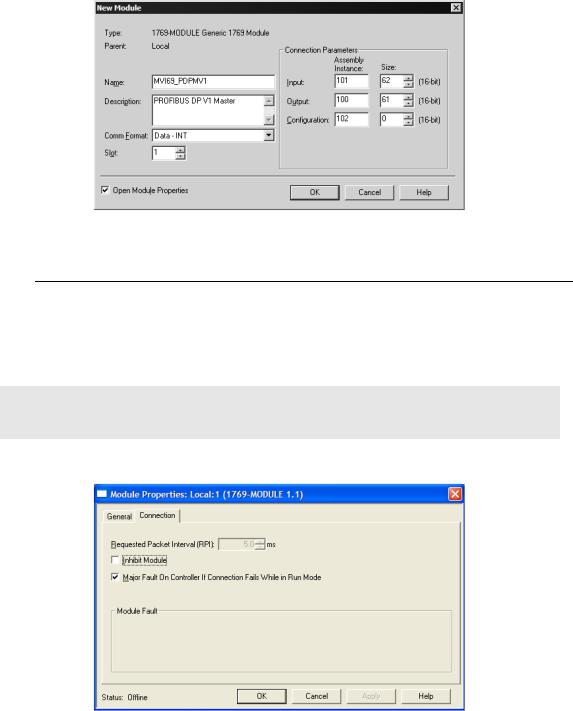
MVI69-PDPMV1 ♦ CompactLogix or MicroLogix Platform |
Ladder Logic |
PROFIBUS DPV1 Master |
User Manual |
|
|
4The following illustration shows an example where the module was configured for a block transfer size of 60 words (input block size = 62 words, output block size = 61 words):
Enter the Input Block Size and Output Block Size parameters according to the Block Transfer Size to use:
Block Transfer Size |
Input Block Size |
Output Block Size |
60 |
62 |
61 |
120 |
122 |
121 |
240 |
242 |
241 |
|
|
|
Important: You must set the Block Transfer Size in ProSoft Configuration Builder to match the block size for the Add-On Instruction, otherwise the module may not function correctly.
5 On the CONNECTION tab, check or un-check, as desired the Major fault option.
ProSoft Technology, Inc. |
Page 23 of 225 |
July 8, 2011 |
|

Ladder Logic |
MVI69-PDPMV1 ♦ CompactLogix or MicroLogix Platform |
User Manual |
PROFIBUS DPV1 Master |
|
|
Now the MVI69-PDPMV1 module will be visible at the I/O Configuration section.
2.1.3 Importing the Ladder Rung
1Open your application in RSLogix 5000.
2To create a new routine, expand the TASKS folder, and then expand the MAIN TASK folder.
3On the MAIN PROGRAM folder, click the right mouse button to open a shortcut menu. On the shortcut menu, choose NEW ROUTINE.
4In the New Routine dialog box, enter the name and description of your routine, and then click OK. In this example we are demonstrating the importing of the ladder rung using the default MainRoutine. In the case where you create a routine by an other name for placing the Add-On Instruction, then in your original routine where your other ladder logic is located you need to add a rung with a jump instruction to the new routine holding the Add-On Instruction.
5Select an empty rung in the new routine, and then click the right mouse button to open a shortcut menu. On the shortcut menu, choose IMPORT RUNG.
Page 24 of 225 |
ProSoft Technology, Inc. |
|
July 8, 2011 |

MVI69-PDPMV1 ♦ CompactLogix or MicroLogix Platform |
Ladder Logic |
PROFIBUS DPV1 Master |
User Manual |
|
|
6Select the AOI69PDPMV1_60.L5X file for the block size you selected for the module (60, 120 or 240).
7The following window will be displayed showing the controller tags to be created during the import procedure: If desired, the description, "MVI69PDPMV1 Interface AOI" may be typed into the description field for
AOI69PDPMV1_60.L5X file.
ProSoft Technology, Inc. |
Page 25 of 225 |
July 8, 2011 |
|
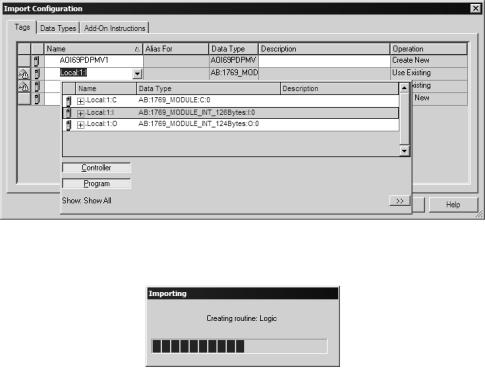
Ladder Logic |
MVI69-PDPMV1 ♦ CompactLogix or MicroLogix Platform |
User Manual |
PROFIBUS DPV1 Master |
|
|
8If you are using the module in a different slot (or remote rack), select the correct connection input and output variables associated to the module. If your module is located in slot 1 of the local rack, this step is not required.
Click OK to confirm the import. RSLogix will indicate that the import is in progress:
Page 26 of 225 |
ProSoft Technology, Inc. |
|
July 8, 2011 |

MVI69-PDPMV1 ♦ CompactLogix or MicroLogix Platform |
Ladder Logic |
PROFIBUS DPV1 Master |
User Manual |
|
|
The imported rung will contain the Add-On Instruction as shown in the following illustration. Notice that the block size is determined by the Add-On Instruction that you imported.
Important: You must set the Block Transfer Size in ProSoft Configuration Builder to match the block size for the Add-On Instruction, otherwise the module may not function correctly.
The procedure has also imported new user-defined data types, data objects and the Add-On Instruction to be used at your project.
ProSoft Technology, Inc. |
Page 27 of 225 |
July 8, 2011 |
|

Ladder Logic |
MVI69-PDPMV1 ♦ CompactLogix or MicroLogix Platform |
User Manual |
PROFIBUS DPV1 Master |
|
|
2.1.4 Adding Multiple Modules (Optional)
Important: If your application requires more than one MVI69-PDPMV1 module into the same project, follow the steps below and make certain that both modules are assigned identical Block Transfer Sizes.
1In the I/O CONFIGURATION folder, click the right mouse button to open a shortcut menu, and then choose NEW MODULE.
2 Select 1769-MODULE.
Page 28 of 225 |
ProSoft Technology, Inc. |
|
July 8, 2011 |
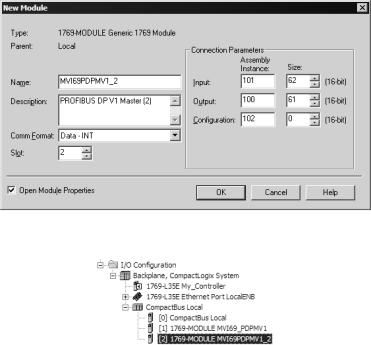
MVI69-PDPMV1 ♦ CompactLogix or MicroLogix Platform |
Ladder Logic |
PROFIBUS DPV1 Master |
User Manual |
|
|
3 Fill the module properties as follows:
Parameter |
Value |
Name |
Enter a module identification string. Example: |
|
MVI69PDPMV1_2 |
Description |
Enter a description for the module. Example: PROFIBUS |
|
DPV1 MASTER |
Comm Format |
Select DATA-INT |
Slot |
Enter the slot number in the rack where the MVI69- |
|
PDPMV1 module will be located. |
Input Assembly Instance |
101 |
Input Size |
62 / 122 / 242 |
Output Assembly Instance |
100 |
Output Size |
61 / 121 / 241 |
Configuration Assembly Instance |
102 |
Configuration Size |
0 |
4Click OK to confirm. The new module is now visible:
5Expand the TASKS folder, and then expand the MAINTASK folder.
6On the MAINPROGRAM folder, click the right mouse button to open a shortcut menu. On the shortcut menu, choose NEW ROUTINE.
7In the New Routine dialog box, enter the name and description of your routine, and then click OK.
ProSoft Technology, Inc. |
Page 29 of 225 |
July 8, 2011 |
|
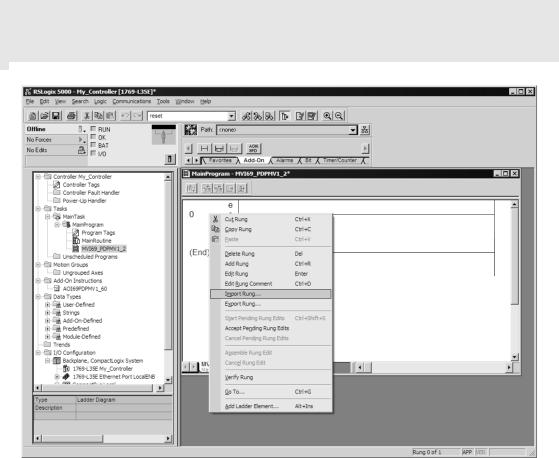
Ladder Logic |
MVI69-PDPMV1 ♦ CompactLogix or MicroLogix Platform |
User Manual |
PROFIBUS DPV1 Master |
|
|
8Select an empty rung in the new routine, and then click the right mouse button to open a shortcut menu. On the shortcut menu, choose IMPORT RUNG.
Note: It is not necessary to create a completely new routine. It is possible to add the MVI69PDPMV1_2 module in the previously created routine. If you need to create a new routine, insert a jump instruction in the previous routine to the new routine.
|
|
|
|
|
|
|
|
Page 30 of 225 |
ProSoft Technology, Inc. |
||
|
|
July 8, 2011 |
|
